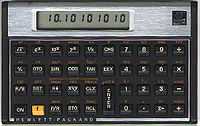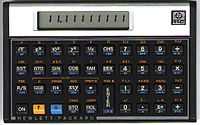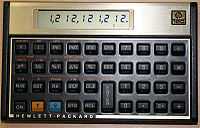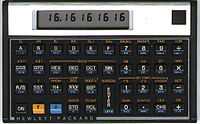Hewlett-Packard Voyager series
|
HP-10C | |
| Type | Programmable Scientific |
|---|---|
| Manufacturer | Hewlett-Packard |
| Introduced | 1982 |
| Discontinued | 1984 |
| Cost | USD 80 |
| Calculator | |
| Entry mode | RPN |
| Display Type | LCD seven-segment display |
| Display Size | 10 digits |
| CPU | |
| Processor | HP Nut core (1LF5[1]) |
| Programming | |
| Programming language(s) | Keystroke programmable (fully merged) |
| Memory Register | 0…9 |
| Program Steps | 9…79 |
| Other | |
| Power consumption | 0.25 mW |
|
HP-11C | |
| Type | Programmable Scientific |
|---|---|
| Manufacturer | Hewlett-Packard |
| Introduced | 1981 |
| Discontinued | 1989 |
| Cost | $135 |
| Calculator | |
| Entry mode | RPN |
| Display Type | LCD seven-segment display |
| Display Size | 10 digits |
| CPU | |
| Processor | HP Nut core (1LF5 / 1LM2 / 1LQ9[1]) |
| Programming | |
| Programming language(s) | Keystroke programmable (fully merged) |
| Memory Register | 0…20 |
| Program Steps | 63…203 |
| Other | |
| Power consumption | 0.25 mW |
|
HP-12C | |
| Type | Programmable Financial |
|---|---|
| Manufacturer | Hewlett-Packard |
| Introduced | 1981 |
| Discontinued | present |
| Cost | USD 135 |
| Calculator | |
| Entry mode | RPN |
| Display Type | LCD seven-segment display |
| Display Size | 10 digits |
| CPU | |
| Processor | HP Nut core (1LF5 / 1LM2 / 1LQ9 / 1RR2 / 2AF1[1]) / 6502 core (SPLB20D2[1]) (12C Platinum) / 8502 core (GPLB31A) (12C Platinum) / ARM7TDMI core (AT91SAM7L128[1]) |
| Programming | |
| Programming language(s) | Keystroke programmable (fully merged) |
| Memory Register | 0…20 |
| Program Steps |
63…203 |
| Other | |
| Power consumption | 0.25 mW |
|
HP-15C | |
| Type | Programmable Scientific |
|---|---|
| Manufacturer | Hewlett-Packard |
| Introduced | 1982 |
| Discontinued | 1989 |
| Cost | USD 135 (Original) USD 99.99 - USD 179.99 (15C LE) |
| Calculator | |
| Entry mode | RPN |
| Display Type | LCD seven-segment display |
| Display Size | 10 digits |
| CPU | |
| Processor | HP Nut core (1LF5 / 1LM2 / 1LQ9[1]) / ARM7TDMI core (Atmel AT91SAM7L128) (15C LE) |
| Programming | |
| Programming language(s) | Keystroke programmable (fully merged) |
| Memory Register | 0…67 |
| Program Steps | 0…448 |
| Other | |
| Power consumption | 0.25 mW |
|
HP-16C | |
| Type | Programmable, Computer science |
|---|---|
| Manufacturer | Hewlett-Packard |
| Introduced | 1982 |
| Discontinued | 1989 |
| Cost | USD 135 |
| Calculator | |
| Entry mode | RPN |
| Display Type | LCD seven-segment display |
| Display Size | 10 digits |
| CPU | |
| Processor | HP Nut core (1LF5 / 1LM2[1]) |
| Programming | |
| Programming language(s) | Keystroke programmable (fully merged) |
| Memory Register | 0…20 |
| Program Steps | 63…203 |
| Other | |
| Power consumption | 0.25 mW |
The Hewlett-Packard Voyager series of calculators were introduced by Hewlett-Packard in 1981.[2] All members of this series are programmable, use Reverse Polish Notation, and feature continuous memory. Nearly identical in appearance, each model provided different capabilities and was aimed at different user markets.
The HP calculators Voyager series consisted of five models, some of which were manufactured in several variants (with original retail price and years of production):
- HP-10C – basic scientific calculator ($80 1982–84).
- HP-11C – mid-range scientific calculator ($135 1981–89).
- HP-12C – business/financial calculator ($150 1981–present).
- HP-15C – advanced scientific calculator ($135 1982–89, $100–$180 2011).
- HP-16C – computer programmer's calculator ($150 1982–89).
The HP-12C and its derivatives remains in widespread use today and is still available from Hewlett-Packard. The long-discontinued HP-15C was re-released in a "Limited Edition" in 2011 that has again been discontinued.
HP-10C
The HP-10C is the last and lowest-featured calculator in this line, even though its number would suggest an earlier origin. The 10C was a basic scientific programmable. While a useful general purpose RPN calculator, the HP-11C offered twice as much for only a slight increase in price. Designed to be an introductory calculator, it was still costly compared to the competition, and many looking at an HP would just step up to the better HP-11C. Poor sales led to a very short market life, making it one of the most difficult of the series to find today.
HP-11C
The HP-11C is a mid-range scientific programmable calculator.
HP-12C
The HP-12C is a popular financial calculator. It was such a successful model that Hewlett-Packard redesigned it from scratch,[3] added several new functions, and introduced it as the HP-12C Platinum in 2003 and a limited 30th anniversary edition in 2011.[4]
The HP-12C is HP's longest and best-selling product, in continual production since its introduction in 1981.[2] Due to its simple operation for key financial calculations, the calculator long ago became the de facto standard among financial professionals – for example, most investment banks issue HP-12Cs to the members of each incoming class of its investment banking analysts and associates. Its popularity has endured despite the fact that even a simple, but iterative, process such as amortizing the interest over the life of a loan—a calculation which modern spreadsheets can complete almost instantly—can take over a minute with the HP-12C.
Later HP financial calculators are many times as fast with more functions, but none has been as successful. For example, the HP-17B was the presumed successor to the HP-12C, but the newer design never caught up to the HP-12C. HP wisely kept selling the HP-12C along side the HP-17B and its derivatives into the 21st century.
The HP-12C's programming mode is very intuitive and works like a macro operation on a computer. Basically, the keys one would press in the calculating mode to arrive at a solution are entered in the programming mode along with logical operators (if, and, etc.) applicable to the solution. After the programming is complete, the macro will run in computation mode to save the user steps and improve accuracy. There are 99 lines of programmable memory on the HP-12C, and 400 lines on the HP-12C Platinum.
The HP-12C Platinum is a revision to the successful 12C. The 12C Platinum is visibly distinguished by its silver-colored upper half as opposed to the gold-colored plate on the original 12C. The Platinum has a faster processor, larger memory and more built-in functions including the option of algebraic entry.
In 2008 HP quietly supercharged the HP-12C with an Atmel AT91SAM7L128 microprocessor (based on an ARM7TDMI 32-bit microprocessor core), running at 30 MHz when executing code. The processor runs the HP-12C code in emulation mode delivering performance 50-150 times faster than the original, and 10-20 times faster than the Platinum version that continues to be available.
HP-15C
The HP-15C is a high-end scientific programmable with a root-solver and numerical integration. It is able to handle complex numbers and matrix operations. Although out of production, its popularity has led to high prices of $200–400 on the used market[5] and a petition asking HP to restart production. The HP-15C was a replacement for the HP-34C.
HP-15C Limited Edition
After showing a prototype colloquially known as "HP-15C+" at the HHC 2010, HP announced the HP-15C Limited Edition (NW250AA) on September 1, 2011. It is based on a flashable controller utilizing the same ARM7TDMI core already used in the 2008 revision of the 12C but in a different package,[6] an Atmel AT91SAM7L128-AU[7][8][9][10][11] running an emulator written by Cyrille de Brébisson to execute the old HP Nut code much faster than on the original hardware. The calculator was released alongside the HP-12C 30th Anniversary Edition. This model is powered by two CR2032 batteries, and can easily be differentiated from the original model by the "Limited Edition" script below the company logo as well as the black text on brushed metal back label, as opposed to the white text on black of the original.
HP-16C
The HP-16C is a computer programmer's calculator, designed to assist in debugging. It can display numbers in hexadecimal, decimal, octal and binary, and convert numbers from one base to another. A number of specialized functions are provided to assist the programmer, including left- and right-shifting, masking, and bitwise logical operations. HP has (as of 2014) never made another programmer's calculator, but has incorporated the 16C's functions in later calculator models.
Arithmetic
One of the least-known features of this calculator series is the quality of the arithmetic inside them. Hewlett-Packard retained the numerical analyst William Kahan of UC Berkeley, the architect of the IEEE 754 standard for floating-point arithmetic, to design the numerical algorithms implemented by the calculators . He also wrote parts of the manuals.
Programming
The HP Voyager series calculator are keystroke programmable, meaning that it can remember and later execute sequences of keystrokes to solve particular problems of interest to the user. These keystroke programs, in addition to performing any operation normally available on the keyboard, can also make use of conditional and unconditional branching and looping instructions, allowing programs to perform repetitive operations and make decisions.
The available programming features differentiate between the various HP Voyager series calculator systems.
| Function | HP 10C | HP 11C | HP 12C | HP 15C | HP 16C |
|---|---|---|---|---|---|
| BSP / ← [F 1] | No | Yes | No | Yes | Yes |
| LBL [F 2] | No | Yes | No | Yes | Yes |
| GSB/RTN [F 3] | No | Yes | No | Yes | Yes |
| x≤y, x=0 | Yes | Yes | Yes | Yes | Yes |
| x=y, x≠y | No | Yes | No | Yes [F 4] | Yes |
| x<0, x≠0, x>y, x>0 | No | Yes | No | Yes [F 4] | Yes |
| x>0, x≤0, x≥y, x≥0 | No | No | No | Yes [F 4] | No |
| DSE, ISG [F 5] | No | Yes | No | Yes | No |
| DSZ, ISZ [F 5] | No | No | No | No | Yes |
| SF, CF, F? | No | Yes | No | Yes | Yes |
| I (I) [F 6] | No | Yes | No | Yes | Yes |
- ↑ Without BSP (backspace) programs can only be edited by overwriting existing steps.
- ↑ Without LBL (Label) goto commands can reference only absolute program steps.
- ↑ Without GSB (Go Subroutine) / RTN (Return from Subroutine) one cannot write subroutines.
- ↑ 4.0 4.1 4.2 Available via the g TEST n function
- ↑ 5.0 5.1 Without DSZ/DSE (Decrement and Skip) and ISZ/ISG (Increment and Skip) writing loops is difficult.
- ↑ Without indirect addressing only the first 20 (0 .. 19) register can be accessed. Also the programming model is not turing complete.
Clones: DM-1XC
The DM-1x series is a series of credit-card-sized calculators made by Swiss Micros (not affiliated with HP) running Voyager series firmware and looking like miniature versions of their HP equivalents. The series consists of DM-15, DM-16, DM-12, DM-11, DM-10.[12] All calculators use the same hardware, but differ in keyboard and firmware (which can be changed with an upgrade port). These devices are essentially functional clones of the original HP models.
References
- ↑ 1.0 1.1 1.2 1.3 1.4 1.5 1.6
- ↑ 2.0 2.1 Furr, Richard ‘Rick’ (January 22, 2003). "HP Calculators by Date of Introduction". The Calculator Reference.
- ↑ Eric Smith (August 16, 2007). "HP Voyager Calculator Variants". HP Voyager Calculator Variants.
- ↑ HP Limited Edition Calculator
- ↑ Completed sales of HP-15C on eBay, March 8, 2008
- ↑ "HP Press Release".
- ↑ http://www.finetune.co.jp/~lyuka/interests/calc/hp15cle/
- ↑ http://media.digikey.com/pdf/PCNs/Atmel/RE133101_AT91SAM7Lxx_Obs.pdf
- ↑ http://media.digikey.com/pdf/PCNs/Atmel/RE133101_AT91SAM7Lxxx_Retract.pdf
- ↑ http://media.digikey.com/pdf/PCNs/Atmel/SE133406A_Obs.pdf
- ↑ http://media.digikey.com/pdf/PCNs/Atmel/RE150402.pdf
- ↑ "SwissMicros.com". Retrieved 2013-06-29.
External links
- David G. Hicks. "HP 10C Series Technology and Packaging". Museum of HP Calculators.
- Eric Smith. "Hewlett-Packard Calculators".
- "HP-10C". "HP-11C". "HP-15C".
- Howard W. Markstein. "A look inside Hewlett-Packard's HP-11C". ELECTRONIC PACKAGING and PRODUCTION Magazine, MARCH, 1982.
| ||||||||||||||||||||||




